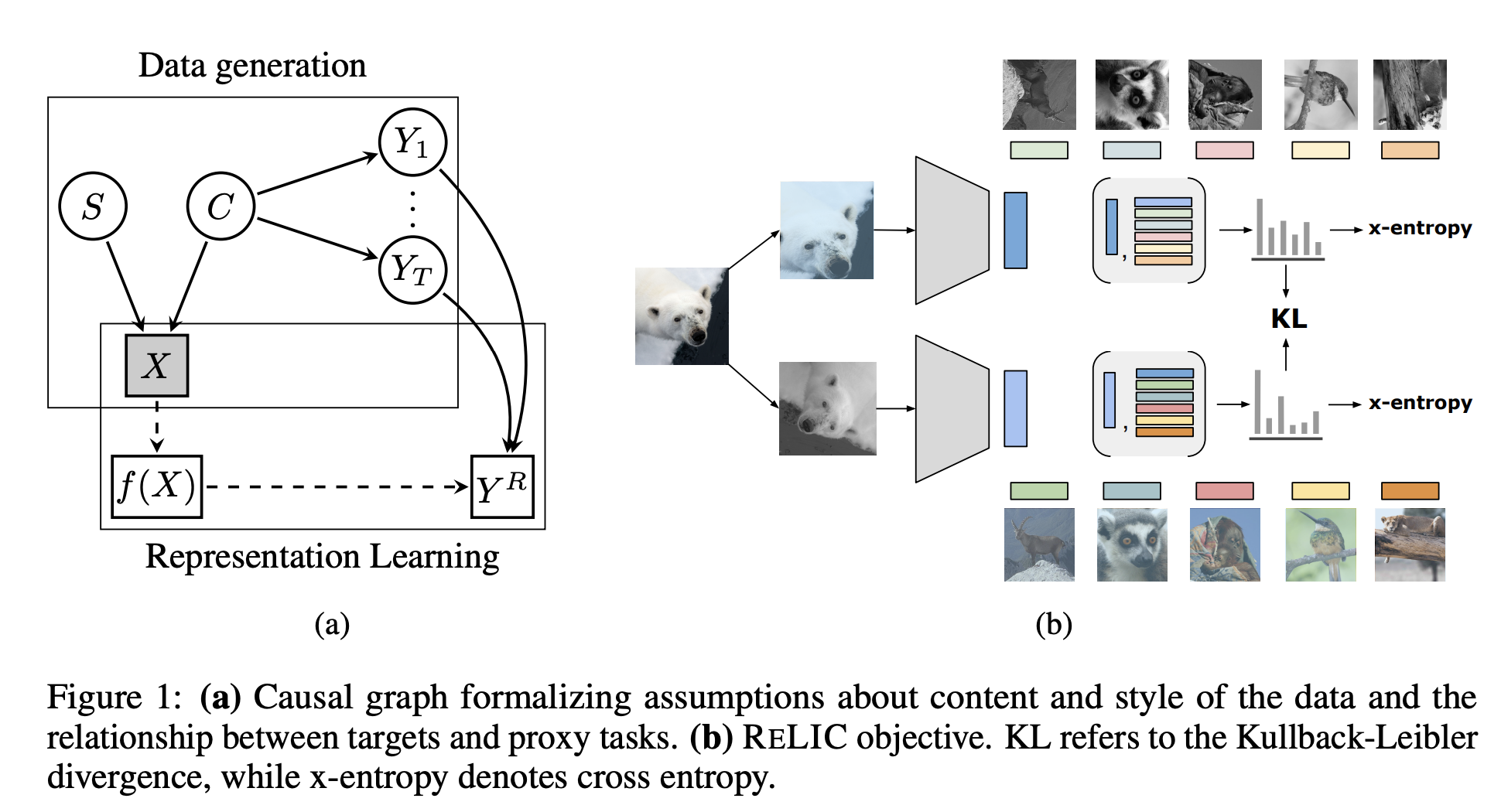Simple self-supervised contrastive based on based on the ReLIC method
Project description
ReLIC
A PyTorch implementation of a computer vision self-supervised learning method based on Representation Learning via Invariant Causal Mechanisms (ReLIC).
This simple approach is very similar to BYOL and SimCLR. The training technique uses a online and target encoder (EMA) with a simple critic MLP projector, while the instance discrimination loss function resembles the contrastive loss used in SimCLR. The other half of the loss function acts as a regularizer - it includes an invariance penalty, which forces the representations to stay invariant under data augmentations and amplifies intra-class distances.
Repo includes the multi-crop augmentation, which is used in the follow-up Pushing the limits of self-supervised ResNets: Can we outperform supervised learning without labels on ImageNet? (ReLICv2) paper. Loss function is extended to support an arbitrary number of small (local) and large (global) views. Using this technique generally results in more robust and higher quality representations.
Also has an experimental support for the sigmoid pairwise loss, from the SigLIP paper. This loss is generally less stable and gives slightly worse metrics, but still yields very good representations.
Results
Models are pretrained on training subsets - for CIFAR10 50,000 and for STL10 100,000 images. For evaluation, I trained and tested LogisticRegression on frozen features from:
CIFAR10- 50,000 train images on ReLICSTL10- features were learned on 100k unlabeled images. LogReg was trained on 5k train images and evaluated on 8k test images.
Linear probing was used for evaluating on features extracted from encoders using the scikit LogisticRegression model.
More detailed evaluation steps and results for CIFAR10 and STL10 can be found in the notebooks directory.
| Evaulation model | Dataset | Feature Extractor | Encoder | Feature dim | Projection Head dim | Epochs | Top1 % |
|---|---|---|---|---|---|---|---|
| LogisticRegression | CIFAR10 | ReLIC | ResNet-18 | 512 | 64 | 100 | 82.53 |
| LogisticRegression | STL10 | ReLIC | ResNet-18 | 512 | 64 | 100 | 77.12 |
| LogisticRegression | STL10 | ReLIC | ResNet-50 | 2048 | 64 | 100 | 81.95 |
Here is a link to a resnet18 encoder trained on the ImageNet-1k subset. This models pefroms better on both CIFAR10 and STL10.
Usage
Instalation
$ pip install relic-pytorch
Code currently supports ResNet18, ResNet50 and an experimental version of the EfficientNet model. Supported datasets are STL10 and CIFAR10.
All training is done from scratch.
Examples
CIFAR10 ResNet-18 model was trained with this command:
relic_train --dataset_name "cifar10" --encoder_model_name resnet18 --fp16_precision --gamma 0.99 --alpha 1.0
STL10 ResNet-50 model was trained with this command:
relic_train --dataset_name "stl10" --encoder_model_name resnet50 --fp16_precision
Detailed options
Once the code is setup, run the following command with optinos listed below:
relic_train [args...]⬇️
ReLIC
options:
-h, --help show this help message and exit
--dataset_path DATASET_PATH
Path where datasets will be saved
--dataset_name {stl10,cifar10}
Dataset name
-m {resnet18,resnet50,efficientnet}, --encoder_model_name {resnet18,resnet50,efficientnet}
model architecture: resnet18, resnet50 or efficientnet (default: resnet18)
-save_model_dir SAVE_MODEL_DIR
Path where models
--num_epochs NUM_EPOCHS
Number of epochs for training
-b BATCH_SIZE, --batch_size BATCH_SIZE
Batch size
-lr LEARNING_RATE, --learning_rate LEARNING_RATE
-wd WEIGHT_DECAY, --weight_decay WEIGHT_DECAY
--fp16_precision Whether to use 16-bit precision GPU training.
--proj_out_dim PROJ_OUT_DIM
Projector MLP out dimension
--proj_hidden_dim PROJ_HIDDEN_DIM
Projector MLP hidden dimension
--log_every_n_steps LOG_EVERY_N_STEPS
Log every n steps
--gamma GAMMA Initial EMA coefficient
--use_siglip Whether to use siglip loss.
--alpha ALPHA Regularization loss factor
--update_gamma_after_step UPDATE_GAMMA_AFTER_STEP
Update EMA gamma after this step
--update_gamma_every_n_steps UPDATE_GAMMA_EVERY_N_STEPS
Update EMA gamma after this many steps
Citation
@misc{mitrovic2020representation,
title={Representation Learning via Invariant Causal Mechanisms},
author={Jovana Mitrovic and Brian McWilliams and Jacob Walker and Lars Buesing and Charles Blundell},
year={2020},
eprint={2010.07922},
archivePrefix={arXiv},
primaryClass={cs.LG}
}
@misc{zhai2023sigmoid,
title={Sigmoid Loss for Language Image Pre-Training},
author={Xiaohua Zhai and Basil Mustafa and Alexander Kolesnikov and Lucas Beyer},
year={2023},
eprint={2303.15343},
archivePrefix={arXiv},
primaryClass={cs.CV}
}
Project details
Download files
Download the file for your platform. If you're not sure which to choose, learn more about installing packages.
Source Distribution
Built Distribution
Hashes for relic_pytorch-0.4.1-py3-none-any.whl
| Algorithm | Hash digest | |
|---|---|---|
| SHA256 | 073b4e166c3ea36fdb9cc38dfd14b61e7fdd20d241aefdf1e458f533ff49671c |
|
| MD5 | 6eed70dcaf55a84474e1cd9b34269544 |
|
| BLAKE2b-256 | 319efadba7a3abfaf4c9ed4cf6eec8e257d80ae1bc1429668eae15498830954d |













